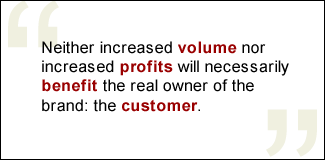It's no stretch to say that customer engagement provides a sharper and more relevant picture of brand health than do any number of other measures that companies and analysts typically rely on. Engagement reveals the extent to which a company has created strong -- and valuable -- brand marriages and it provides a sensitive monitor of the ebb and flow of the company's brand relationships.
That's not how most companies gauge their business success. In part, it's because they've had no credible metrics that could reliably reflect their relationship-building success. But it's also because that's not what Wall Street looks at. As a result, engagement hasn't been relied upon as one of the key factors that drive a company's stock value, even though it's abundantly clear that a company's customers ultimately determine the company's worth.
 |
Wall Street, however, tends to value sales, market share, and volume growth. For an automaker, it's growth in the numbers of vehicles it sells and in the total profits it makes. For a soap maker, it's growth in market share and total profits. For retailers, it's total sales volume growth -- but with special attention to same-store "comp" sales growth, or the volume increases seen in stores that have been open for at least a year.
Growth is the focus, even though research shows that bigger is not always better. Richard Miniter's The Myth of Market Share analyzes whether market share is an indicator of brand health, and concludes that it isn't. Miniter cites one study of 3,000 companies, which found that "more than 70% of the time, the firm with the biggest share of the market doesn't have the highest rate of return." The focus, Miniter contends -- and we agree -- should be on the customer, not on the competition.
That's a significant problem. Whatever a company identifies as a key goal will obviously become a critical objective that guides every company manager's plans and programs. For a good many of them, the goal will become an obsession and the cause of their sleepless nights.
So if the identified key goal is volume and share growth, managers will look to programs that will quickly and efficiently help to achieve them. Price-cutting is certainly one way; management can implement price reductions, deep discounts, and 0% financing. Products will move, at least in the short term, but at what cost?
 |
If the key goal is company profits, then managers can pursue another direction, cutting the costs of doing business so these expenses can instead go directly to boost the bottom line. Profits will increase, at least in the short term, but at what cost?
Neither increased volume nor increased profits will necessarily benefit the real owner of the brand: the customer. And if there's no benefit to the customer, the company not only fails to enhance the brand marriage, it weakens it. When customer engagement slides, so do a great many other outcomes, including future sales, growth, and profit.
Instead, companies should focus on an objective that merits the diligent, even obsessive attention of the company's managers: customer engagement, and healthy brand marriages. Every manager should be laser-focused on building and protecting the company's most precious assets -- its powerful and passionate customer relationships. These brand relationship assets determine the continued health and future success of the company.